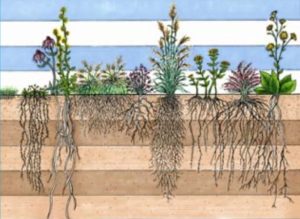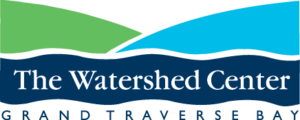Stormwater
What is Stormwater?
One of the major ways pollutants get to lakes and streams is through stormwater runoff. Stormwater runoff results when rain falls
to the ground – or snow melts – and the water that does not infiltrate into the ground flows over the surface of the land. The flow of this stormwater often dislodges and carries pollutants such as oil, grease, gas, toxins, and bacteria, as well as sediment particles and the pollutants that are attached. The amount of stormwater runoff that occurs depends on a variety of conditions including storm intensity and duration, topography, time of year, soil moisture levels, soil permeability, vegetative cover types, the extent of vegetated cover, and the amount of impervious surfaces.
Urban locations such as Traverse City, Elk Rapids, and Suttons Bay often produce greater amounts of stormwater runoff due to the increased amount of impervious surfaces relative to more rural settings within the watershed. Impervious surfaces are areas that cannot effectively absorb or infiltrate rainfall or snowmelt, including roads, streets, sidewalks, parking lots, and rooftops. Additionally, urban areas are likely to have stormwater systems that direct stormwater through ditches and underground pipes before being discharged directly into a waterbody leading to increased stormwater volume and pollutant loads at storm drain outlets.
Why is it a Threat?
Stormwater entering Grand Traverse Bay and its tributaries from storm drain outlets contributes a significant amount of pollution; most often pollution from storm drains is worst during heavy rains and snowmelt events. However, stormwater runoff also enters waterways through ditches and overland flows, as well as at road stream crossings. Contributions from all these stormwater inputs can result in a massive amount of pollution entering our waterbodies and ultimately Grand Traverse Bay.
Stormwater runoff from coastal urban areas along the Grand Traverse Bay shoreline can cause localized elevated levels of nutrients in the nearshore area compared to lower levels seen offshore. Runoff also contributes directly to thermal pollution as stormwater is warmed when it runs over the surface of the land. Spikes of warm temperatures can be seen when stormwater runoff reaches a stream and can be fatal to fish and other aquatic life. Additionally, harmful bacteria and pathogens such as E.coli are carried to waterbodies via stormwater. Many urban areas see spikes in bacterial levels in nearby recreational waters after rain events. Learn more about Healthy Beaches.
The impact of nutrient inputs on the nearshore area of the bay was demonstrated in an aquatic plant study we conducted in 2009. Aquatic plant growth was evaluated with a variety of water and sediment testing for nitrogen and phosphorous that showed a six-fold increase in the number of plant beds identified between 1991 and 2009. Most of the aquatic plant beds were concentrated in embayments such as Northport and Omena bays, as well as the southern end of west Grand Traverse Bay where the Boardman River drains. This growth is attributed to rapid development and nutrient flushing from stormwater inputs, particularly the amount of phosphorus entering the bay.
What Can Be Done to Minimize/Eliminate Stormwater Impacts?
One of the best ways to reduce stormwater and its harmful impacts on water quality and ecosystem health is to implement practices known collectively as green infrastructure techniques. Green infrastructure mimics and works with nature to reduce stormwater runoff onsite using green space, native landscaping, and other techniques to encourage water to infiltrate into the ground.
Since stormwater carries most pollutants to waterbodies, green infrastructure can significantly reduce the amount of pollution entering a waterbody because it reduces or eliminates runoff from a site. Additionally, green infrastructure can help reduce flooding, channel erosion, and scouring downstream. At the city or county scale, GI can be a patchwork of natural areas that provides habitat, flood protection, cleaner air, and cleaner water. At the neighborhood or site scale, stormwater management systems that mimic nature soak up and store water.
Green infrastructure is applicable to new and existing developments and can be integrated into virtually any site, from the residential scale to larger sites such as commercial areas. The range of techniques continues to expand and new advances in design provide greater water quality benefits. According to the U.S. Environmental Protection Agency, along with improving water quality, green infrastructure practices also save substantial money for property owners, communities, and developers by decreasing the amount
of expensive below ground drainage infrastructure required and reducing or eliminating the need for other stormwater-related facilities such as curbs, erosion control measures, catch basins, and outlet control structures.
In addition to water quality benefits, green infrastructure also provides ecosystem services and associated economic benefits that conventional stormwater controls (e.g., detention basins) do not. Ecosystem services are the many and varied benefits that we gain from the natural environment and properly functioning ecosystems.

Examples of ecological services include purification of air and water, maintenance of biodiversity, decomposition of wastes, soil and vegetation generation and renewal, pollination of crops and natural vegetation, groundwater recharge through wetlands, seed dispersal, greenhouse gas mitigation, and aesthetically pleasing landscapes.
Green infrastructure also stresses the use of native plants, which typically have much deeper root systems than turf grass. This dramatically increases infiltration at a site, as well as uptake of nutrients
Examples of green infrastructure practices include rain gardens, rain barrels, pervious pavement, downspout planter boxes, green roofs, and storm tree boxes. The Watershed Center has installed numerous green infrastructure techniques throughout the Grand Traverse Bay watershed.
Resources
EPA Green Infrastructure Website
EPA Stormwater Calculator
EPA’s Spreadsheet Tool for Estimating Pollutant Loads
Great Lakes Stormwater Collaborative
Michigan EGLE Stormwater Permit Program
Michigan EGLE Nonpoint Source Program
SEMCOG Low Impact Development Manual
Center for Neighborhood Technology – Green Values® Calculator: compares the performance, costs, and benefits of Green Infrastructure to conventional stormwater practices
